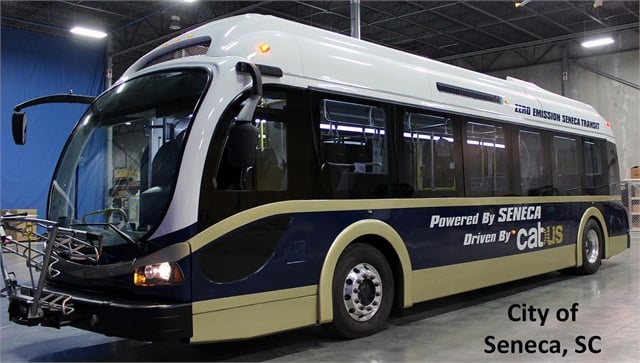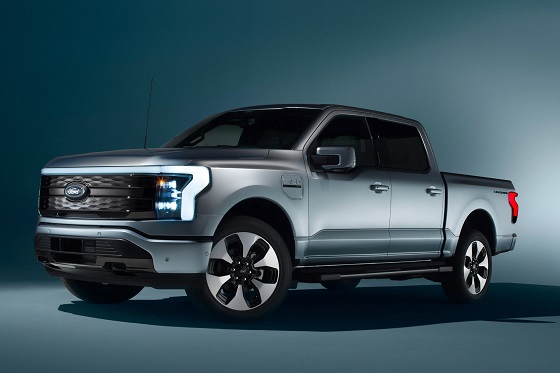Automotive
World’s first all-electric bus fleet shut down due to breakdowns and expense

From Heartland Daily News
Electric Buses Not a Panacea
Last week, the city of Seneca, South Carolina decided to shut down the Clemson Area Transit System, which served Seneca and nearby Clemson University. Once touted as owning the world’s first all-electric bus fleet, just a few years later two thirds of its expensive electric buses had broken down, the company that made them went bankrupt, parts were no longer available, and the city can’t afford to buy replacement buses.
Seneca is not exactly a major metropolis. But Clemson Area Transit isn’t the only transit agency to have trouble with electric buses. Just the day before Seneca decided to shut down its transit system, Austin’s Capital Metro announced that it was giving up on its plan to electrify its bus fleet by 2030. Electric bus technology, said the agency, simply hasn’t progressed far enough to replace Diesels.
California’s Foothill Transit, one of the first agencies to use rapid-charge electric buses in 2010, has also had problems. Like Austin, the agency had hoped to completely electrify by 2030. Instead, by 2020 most of the electric buses in its fleet were out of service. In 2021, the agency decided to return the buses even though doing so would require it to pay a $5 million penalty to the Federal Transit Administration, whose grant initially paid most of the cost.
The Southeast Pennsylvania Transportation Authority (SEPTA) may be the largest agency to have practically given up on electric buses. It pulled its 25-bus electric fleet out of service in 2021 when the buses were just five years old. The buses had suffered cracks in their chassis, but it appears that problem was only the straw that broke the omnibus’s back. “We do not feel the current [electric bus] technology is a good investment at this time,” concluded SEPTA’s general manager.
Transit agencies in Asheville, Colorado Springs, and several other cities have reported similar problems. Albuquerque completely gave up on its electric buses and returned them to the manufacturer, a Chinese company called BYD.
Electric buses cost 50 to 100 percent more than their Diesel counterparts. A 2019 study by US PIRG predicted that such buses would nevertheless save transit agencies $400,000 apiece over their lifetimes due to lower fuel and maintenance costs. US PIRG relied on four “success stories” to justify this conclusion. Success story number one was Seneca, South Carolina.
The report acknowledged Albuquerque’s problems but blamed them on the city’s hills and high temperatures. Compared with Austin, Albuquerque is practically flat and its temperatures are nowhere near as extreme. If electric buses can’t work in Albuquerque, they aren’t going to work in a lot of other cities.
Other than Albuquerque, one thing many of these failures have in common is electric buses manufactured by Proterra, one of four major electric bus manufacturers that have recently sold buses in the U.S. and the only one to actually be a U.S. company. In 2023, it claimed that COVID-related supply-chain problems had driven it into bankruptcy. The company’s three divisions — transit buses, batteries and drive trains, and charging systems — were sold to three other companies to pay Proterra’s debts and none of the buyers are supporting Proterra’s buses or even making similar buses. In view of the many problems transit agencies were having with its buses before 2023, it seems likely the supply-chain explanation was just a dodge for Proterra’s shoddy design and workmanship.
One reason for that may simply be opportunism on the part of bus manufacturers, including both Proterra and BYD. Before passage of the 2021 infrastructure bill, the federal government was paying 80 percent of the cost of Diesel buses but 90 percent of the cost of electric buses purchased by transit agencies. For a transit agency, that meant that an electric bus could cost twice as much as a Diesel bus without costing local taxpayers an extra dime. Bus manufacturers thus felt free to increase their profits by raising the price of their electric buses and, having done so, may have compounded the problem by cutting costs.
Beyond manufacturing defects, electric buses have several generic problems. First, while a Diesel bus can operate all day, an electric bus can operate only a few hours on a single time-consuming charge. Proterra claimed to have solved this problem with a rapid-charge system, but that didn’t prevent Foothill Transit from suffering enormous problems with its electric buses. This probably is particularly serious on long bus routes: Austin’s Capital Metro estimates that today’s electric buses could satisfactorily serve only 36 percent of its routes.
Second, the batteries needed to power electric bus motors are heavy, which is probably why SEPTA’s buses suffered cracks in their chassis. Supposedly, the frames on SEPTA’s Proterra buses were made of “resin, fiberglass, carbon fiber, balsa wood, and steel reinforcement plates,” which almost sounds like a joke. But making frames strong enough to support the batteries means adding even more weight to the buses, which shortens their range and adds to wear and tear on other parts of the buses.
Third, electric buses are not necessarily climate-friendly enough to justify their added cost. In Washington state, where most electric power comes from hydroelectric dams, switching from Diesel to electric buses will definitely reduce greenhouse gas emissions. But most other states, including New Mexico, South Carolina, and Texas, get most of their electricity from fossil fuels and thus electric buses may not reduce greenhouse gas emissions at all when compared with Diesels.
Under the 2021 infrastructure law, the federal government is handing out close to a billion dollars to buy electric buses. Advocacy groups such as US PIRG want transit agencies to “commit to a full transition to electric buses on a specific timeline.” Such funding and commitment may be premature, however, if electric bus technology is not capable of equalling Diesel buses, will cost agencies more in the long run, and won’t do much to reduce greenhouse gas emissions.
The Antiplanner is a forester and economist with more than fifty years of experience critiquing government land-use and transportation plans.
Originally published by The Antiplanner. Republished with permission.
Automotive
Canada’s EV gamble is starting to backfire

Things have only gone from bad to worse for the global Electric Vehicle industry. And that’s a problem for Canada, because successive Liberal governments have done everything in their power to hitch our cart to that horse.
Earlier this month, the Trump Administration rolled back more Biden-era regulations that effectively served as a back-door EV mandate in the United States. These rules mandated that all passenger cars be able to travel at least 65.1 miles (and for light trucks, 45.2 miles) per gallon of gasoline or diesel, by the year 2031. Since no Internal Combustion Engine (ICE) vehicle could realistically conform to those standards, that would have essentially boxed them out of the market.
Trump’s rolling them back was a fulfillment of his campaign promise to end the Biden Administration’s stealth EV mandates. But it was also a simple recognition of the reality that EVs can’t compete on their own merits.
For proof of that, look no further than our second bit of bad news for EVs: Ford Motor Company has just announced a massive $19.5 billion write-down, almost entirely linked to its aggressive push into EVs. They’ve lost $13 billion on EVs in the past two years alone.
The company invested tens of billions on these go-carts, and lost their shirt when it turned out the market for them was miniscule.
Ford’s EV division president Andrew Frick explained, “Ford is following the customer. We are looking at the market as it is today, not just as everyone predicted it to be five years ago.”
Of course, five years ago, the market was assuming that government subsidies-plus-mandates would create a market for EVs at scale, which hasn’t happened.
As to what this portends for the market, the Wall Street Journal argued, “The company’s pivot from all-electric vehicles is a fresh sign that America’s roadways – after a push to remake them – will continue to look in the near future much like they do today, with a large number of gas-powered cars and trucks and growing use of hybrids.”
And that’s not just true in the U.S. Across the Atlantic, reports suggest the European Union is preparing to delay their own EV mandates to 2040. And the U.K.’s Labour government is considering postponing their own 2030 ICE vehicle ban to align with any EU change in policy.
It’s looking like fewer people around the world will be forced by their governments to buy EVs. Which means that fewer people will be buying EVs.
Now, that is a headache for Canada. Our leaders, at both the federal and provincial levels, have bet big on the success of EVs, investing billions in taxpayer dollars in the hopes of making Canada a major player in the global EV supply chain.
To bolster those investments, Ottawa introduced its Electric Vehicle mandate, requiring 100 per cent of new light-duty vehicle sales to be electric by 2035. This, despite the fact that EVs remain significantly more expensive than gas-and-diesel driven vehicles, they’re poorly suited to Canada’s vast distances and cold climate, and our charging infrastructure is wholly inadequate for a total transition to EVs.
But even if these things weren’t true, there still aren’t enough of us to make the government’s investment make sense. Their entire strategy depends on exporting to foreign markets that are rapidly cooling on EVs.
Collapsing demand south of the border – where the vast majority of the autos we build are sent – means that Canadian EVs will be left without buyers. And postponed (perhaps eventually canceled) mandates in Europe mean that we will be left without a fallback market.
Canadian industry voices are growing louder in their concern. Meanwhile, plants are already idling, scaling back production, or even closing, leaving workers out in the cold.
As GM Canada’s president, Kristian Aquilina, said when announcing her company’s cancellation of the BrightDrop Electric delivery van, “Quite simply, we just have not seen demand for these vehicles climb to the levels that we initially anticipated…. It’s simply a demand and a market-driven response.”
Prime Minister Mark Carney, while sharing much of the same environmental outlook as his predecessor, has already been compelled by economic realities to make a small adjustment – delaying the enforcement of the 2026 EV sales quotas by one year.
But a one-year pause doesn’t solve the problem. It kicks the can down the road.
Mr. Carney must now make a choice. He can double down on this troubled policy, continuing to throw good money after bad, endangering a lot of jobs in our automotive sector, while making transportation more expensive and less reliable for Canadians. Or he can change course: scrap the mandates, end the subsidies, and start putting people and prosperity ahead of ideology.
Here’s hoping he chooses the latter.
The writing is on the wall. Around the world, the forced transition to EVs is crashing into economic reality. If Canada doesn’t wake up soon, we’ll be left holding the bag.
Automotive
Ford’s EV Fiasco Fallout Hits Hard


From the Daily Caller News Foundation
I’ve written frequently here in recent years about the financial fiasco that has hit Ford Motor Company and other big U.S. carmakers who made the fateful decision to go in whole hog in 2021 to feed at the federal subsidy trough wrought on the U.S. economy by the Joe Biden autopen presidency. It was crony capitalism writ large, federal rent seeking on the grandest scale in U.S. history, and only now are the chickens coming home to roost.
Ford announced on Monday that it will be forced to take $19.5 billion in special charges as its management team embarks on a corporate reorganization in a desperate attempt to unwind the financial carnage caused by its failed strategies and investments in the electric vehicles space since 2022.
Cancelled is the Ford F-150 Lightning, the full-size electric pickup that few could afford and fewer wanted to buy, along with planned introductions of a second pricey pickup and fully electric vans and commercial vehicles. Ford will apparently keep making its costly Mustang Mach-E EV while adjusting the car’s features and price to try to make it more competitive. There will be a shift to making more hybrid models and introducing new lines of cheaper EVs and what the company calls “extended range electric vehicles,” or EREVs, which attach a gas-fueled generator to recharge the EV batteries while the car is being driven.
Dear Readers:
As a nonprofit, we are dependent on the generosity of our readers.
Please consider making a small donation of any amount here.
Thank you!
“The $50k, $60k, $70k EVs just weren’t selling; We’re following customers to where the market is,” Farley said. “We’re going to build up our whole lineup of hybrids. It’s gonna be better for the company’s profitability, shareholders and a lot of new American jobs. These really expensive $70k electric trucks, as much as I love the product, they didn’t make sense. But an EREV that goes 700 miles on a tank of gas, for 90% of the time is all-electric, that EREV is a better solution for a Lightning than the current all-electric Lightning.”
It all makes sense to Mr. Farley, but one wonders how much longer the company’s investors will tolerate his presence atop the corporate management pyramid if the company’s financial fortunes don’t turn around fast.
To Ford’s and Farley’s credit, the company has, unlike some of its competitors (GM, for example), been quite transparent in publicly revealing the massive losses it has accumulated in its EV projects since 2022. The company has reported its EV enterprise as a separate business unit called Model-E on its financial filings, enabling everyone to witness its somewhat amazing escalating EV-related losses since 2022:
• 2022 – Net loss of $2.2 billion
• 2023 – Net loss of $4.7 billion
• 2024 – Net loss of $5.1 billion
Add in the company’s $3.6 billion in losses recorded across the first three quarters of 2025, and you arrive at a total of $15.6 billion net losses on EV-related projects and processes in less than four calendar years. Add to that the financial carnage detailed in Monday’s announcement and the damage from the company’s financial electric boogaloo escalates to well above $30 billion with Q4 2025’s damage still to be added to the total.
Ford and Farley have benefited from the fact that the company’s lineup of gas-and-diesel powered cars have remained strongly profitable, resulting in overall corporate profits each year despite the huge EV-related losses. It is also fair to point out that all car companies were under heavy pressure from the Biden government to either produce battery electric vehicles or be penalized by onerous federal regulations.
Now, with the Trump administration rescinding Biden’s harsh mandates and canceling the absurdly unattainable fleet mileage requirements, Ford and other companies will be free to make cars Americans actually want to buy. Better late than never, as they say, but the financial fallout from it all is likely just beginning to be made public.
- David Blackmon is an energy writer and consultant based in Texas. He spent 40 years in the oil and gas business, where he specialized in public policy and communications.
-

 International2 days ago
International2 days agoGeorgia county admits illegally certifying 315k ballots in 2020 presidential election
-

 Haultain Research2 days ago
Haultain Research2 days agoSweden Fixed What Canada Won’t Even Name
-

 Business2 days ago
Business2 days agoWhat Do Loyalty Rewards Programs Cost Us?
-

 Energy2 days ago
Energy2 days agoWhy Japan wants Western Canadian LNG
-

 Business2 days ago
Business2 days agoLand use will be British Columbia’s biggest issue in 2026
-

 Business2 days ago
Business2 days agoThe Real Reason Canada’s Health Care System Is Failing
-

 Business2 days ago
Business2 days agoDark clouds loom over Canada’s economy in 2026
-

 Business2 days ago
Business2 days agoFederal funds FROZEN after massive fraud uncovered: Trump cuts off Minnesota child care money





